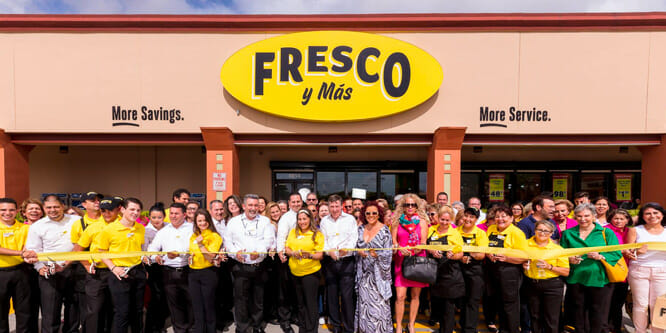
Photo: Fresco Y Más
Bi-Lo, Winn-Dixie parent expects to thrive after Chapter 11
Southeastern Grocers (SEG), parent company of Bi-Lo, Fresco Y Más and Winn-Dixie, has filed for Chapter 11 bankruptcy protection after announcing plans to close 94 stores.
The supermarket operator, which is looking to reduce its debt by more than $500 million, said closing the underperforming stores is necessary, but that doing so will enable the company to work through a restructuring agreement that should have it emerge from bankruptcy within 90 days.
SEG’s Chapter 11 petition lists C&S Wholesale Grocers ($109 million) and Cardinal Health ($50.5 million) among the largest unsecured creditors. Wells Fargo is a trustee on a bond issuance of about $522 million. All other claims against the company are $5 million or less.
A company statement said that SEG will “continue to thrive with 582 successful stores” and that it will move ahead with a three-year plan that involves creating “stunning, remodeled stores” that provide “customers with fresh, new concepts and products to cater to the local tastes and needs of the neighborhoods” it serves.
The banners owned by SEG have been under continuing competitive pressure from Publix and Walmart, which continue to expand throughout the Southeast. Other growing grocery chains, including Aldi and Trader Joe’s, have also chipped away at SEG’s market share.
SEG operates stores in Alabama, Florida, Georgia, Louisiana, Mississippi, North and South Carolina.
Discussion Questions
DISCUSSION QUESTIONS: What conditions led to Southeastern Grocers’ Chapter 11 filing? Do you think that the company and its banners will be in a position to thrive following the debt restructuring?


Maybe Bi-lo bit off more than it could chew when it bought Winn-Dixie out of its bankruptcy with some unrealistic assumptions about growth rates. This is a long-standing problem in retail and it’s not getting better: debt.
Winn-Dixie is in some really challenging markets, especially in Florida where every national grocer and now Aldi are on the scene, and Publix is iconic and has a store every 40 blocks. It’s tough to compete on a good day, but especially when you’re carrying an extra debt load.
Too much debt and out-of-date stores are the two main reasons why SEG needed to file for Chapter 11. But that seems to be the story today for most retailers filing for bankruptcy protection. Technology has changed the world and it is moving at a rapid pace. Today grocers face heavy competition on all fronts from selection to home delivery. So staying on top of every detail is challenging and when you’re carrying significant debt, it’s next to impossible to compete. This restructuring should help SEG, and they can survive if they focus on building the supermarket chain of the future with all the wants today’s customers have.
This is the usual story of underperformance and a heck of a lot of debt. The two make for very unhappy bedfellows.
The fact that much of Southeastern Grocers’ debt becomes due this year is the catalyst for Chapter 11. However, long-term success is not just down to debt reduction and restructuring; it comes down to having a proposition that can compete with Publix, Walmart, Trader Joe’s, Aldi and others.
Things went downhill after the Sweetbay/Harvey’s acquisition. The reorg gets rid of about one-third of their debt and 15 percent of their stores. It gives them better footing, but it’s still the same old story we’ve been hearing from both these chains (both Winn-Dixie and Bi-Lo have filed previously this century) for the past decade-plus. A new plan to remodel and create a store of the future. Despite a projection to return to profitability in 2019, cash flow will remain weak and the balance sheet still somewhat leveraged, so the company will still be handcuffed by how aggressive they can be. Their best chance is if Kroger or Albertsons is interested in the real estate … Amazon?
The glaring challenge (which will likely be an impediment to a long-term turnaround) is the relationship with C&S Wholesale.
The related changes to the procurement agreement are the cornerstones to making the restructure work — given that 70 percent of inventory comes from C&S, current outstanding debt — and how the changes impact cash flow in the short-term.
The issue lies around the statement about providing “customers with fresh, new concepts and products to cater to the local tastes and needs of the neighborhoods.” Strategically this sounds right — but the concept revolves around local, independent and unique product. This becomes very hard to make work given product assortment/inventory is (now more than ever) assured to be tied to a legacy behemoth like C&S.
Suppliers have concerns about the impact this has on business and payments from C&S Wholesale Grocers and also Cardinal Health. I think these companies will need to address these concerns with their valued suppliers and vendors as soon as they are able.
Based on the info provided, I think a better question would be not why they’re seeking bankruptcy, but why they think they can get out of it. Indeed, that they offer a remark like “continue to thrive” (CONTINUE?) suggests a remarkable degree of cluelessness.
I’m going to refrain from my normal practice of offering best wishes, and save it for someone who I think has a chance of making use of them.
We will no doubt hear more stories about the “retail apocalypse” from plenty of mainstream media outlets with this latest announcement. This sad story is really more about trying to grow by opening and acquiring more stores, piling on debt, failing to remodel and modernize the store experience, and overall not having a differentiated value proposition that speaks to customers. If SEG is to thrive post-Chapter 11 then they will need to invest in those stores and come up with new ideas to fuel interest with shoppers. Otherwise, we’ll be hearing additional fake “apocalypse” news in a year when they start closing more stores.